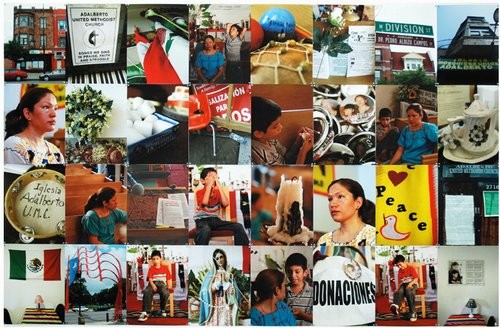Andrea Bowers
11 Apr - 14 Jun 2008

© Anreas Bowers
Mother and Child in Political Sanctuary, Adalberto United Methodist Church, CHicago Il, July2007
Mother and Child in Political Sanctuary, Adalberto United Methodist Church, CHicago Il, July2007
ANDREA BOWERS
"Sanctuary"
April 11 - June 14, 2008
For almost a year Andrea Bowers followed the story of Elvira Arellano in the press. On August 15, 2006, Arellano entered into sanctuary at the Adalberto United Methodist Church in Chicago, IL. She began her vigil against a deportation order to avoid being separated from her eight year old son Saul, who is a U.S. citizen. She refused to return to Mexico because she would not leave behind the child that she had raised by herself for most of his life. Bowers interviewed Arellano two weeks prior to her one-year anniversary in sanctuary. Less than three weeks later, Arellano was separated from her son and deported to Mexico. While involved in one of the most contentious political debates in the U.S. - that of immigration - Arellano's courage and dignity drew me to her story.
This exhibition, Sanctuary, continues Bowers' exploration of direct action and non-violent civil disobedience enacted through the lives of women. She presents the stories of activists to express her belief that dissent is essential to maintaining a democratic process, as well as to illustrate the importance of a political strategy that stands in opposition to violence and war. In this body of work she continues to consider the intersections between aesthetics and political protest. Bowers investigates the role of art in the reconsideration of historical records, storytelling and documentation. Included in the project are a 16 mm film and photographs.
The film Sanctuary focuses on the genre of portraiture, employing the gaze to confront the social and political scrutiny that occurs in spectatorship. Arellano was the first undocumented immigrant to publicly acknowledge her situation. Most people in her circumstances, for obvious reasons, feel they must stay in hiding. Andrea Bowers found her decision to publicly refuse her deportation courageous and this is conveyed through the eye contact she makes with the viewer. In Sanctuary the subjects Elvira and Saul Arellano do not speak, and as a result the judgments and assumptions made during the act of viewing are fore-grounded. The film makes the viewer’s internal dialog conscious, turning the traditionally objectifying gaze on the female subject into a situation for ego identification and mirroring for the viewer.
"Sanctuary"
April 11 - June 14, 2008
For almost a year Andrea Bowers followed the story of Elvira Arellano in the press. On August 15, 2006, Arellano entered into sanctuary at the Adalberto United Methodist Church in Chicago, IL. She began her vigil against a deportation order to avoid being separated from her eight year old son Saul, who is a U.S. citizen. She refused to return to Mexico because she would not leave behind the child that she had raised by herself for most of his life. Bowers interviewed Arellano two weeks prior to her one-year anniversary in sanctuary. Less than three weeks later, Arellano was separated from her son and deported to Mexico. While involved in one of the most contentious political debates in the U.S. - that of immigration - Arellano's courage and dignity drew me to her story.
This exhibition, Sanctuary, continues Bowers' exploration of direct action and non-violent civil disobedience enacted through the lives of women. She presents the stories of activists to express her belief that dissent is essential to maintaining a democratic process, as well as to illustrate the importance of a political strategy that stands in opposition to violence and war. In this body of work she continues to consider the intersections between aesthetics and political protest. Bowers investigates the role of art in the reconsideration of historical records, storytelling and documentation. Included in the project are a 16 mm film and photographs.
The film Sanctuary focuses on the genre of portraiture, employing the gaze to confront the social and political scrutiny that occurs in spectatorship. Arellano was the first undocumented immigrant to publicly acknowledge her situation. Most people in her circumstances, for obvious reasons, feel they must stay in hiding. Andrea Bowers found her decision to publicly refuse her deportation courageous and this is conveyed through the eye contact she makes with the viewer. In Sanctuary the subjects Elvira and Saul Arellano do not speak, and as a result the judgments and assumptions made during the act of viewing are fore-grounded. The film makes the viewer’s internal dialog conscious, turning the traditionally objectifying gaze on the female subject into a situation for ego identification and mirroring for the viewer.
